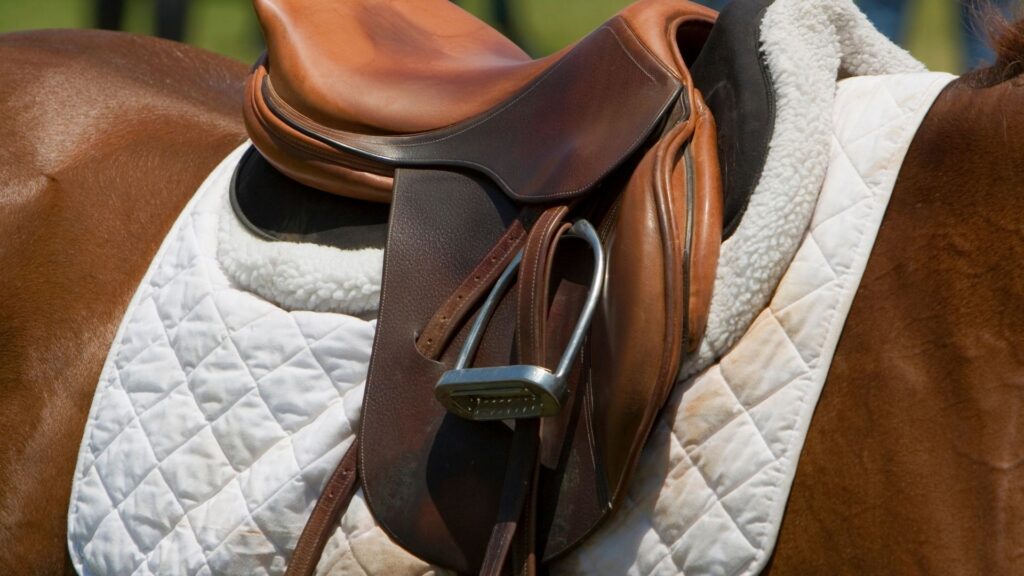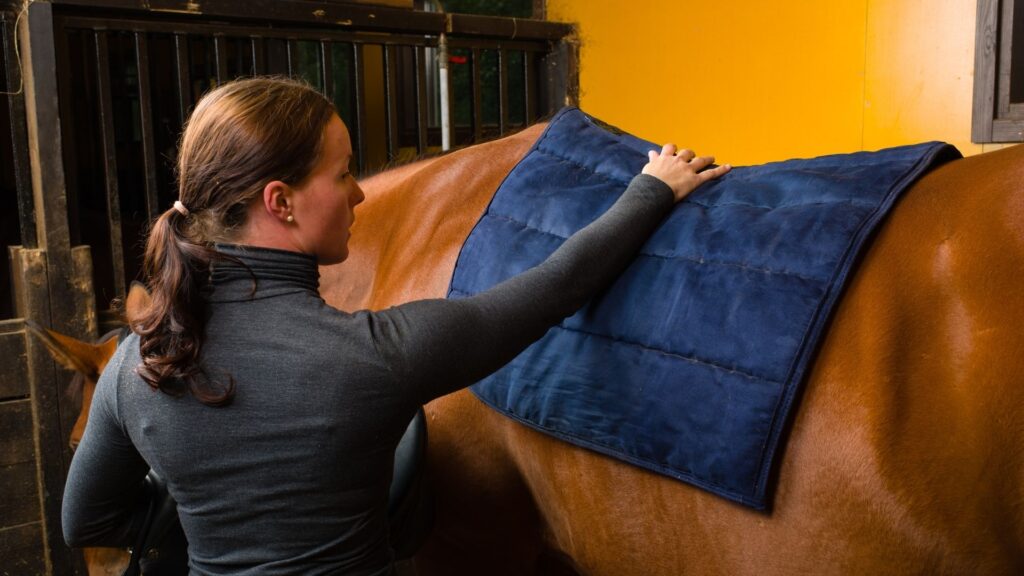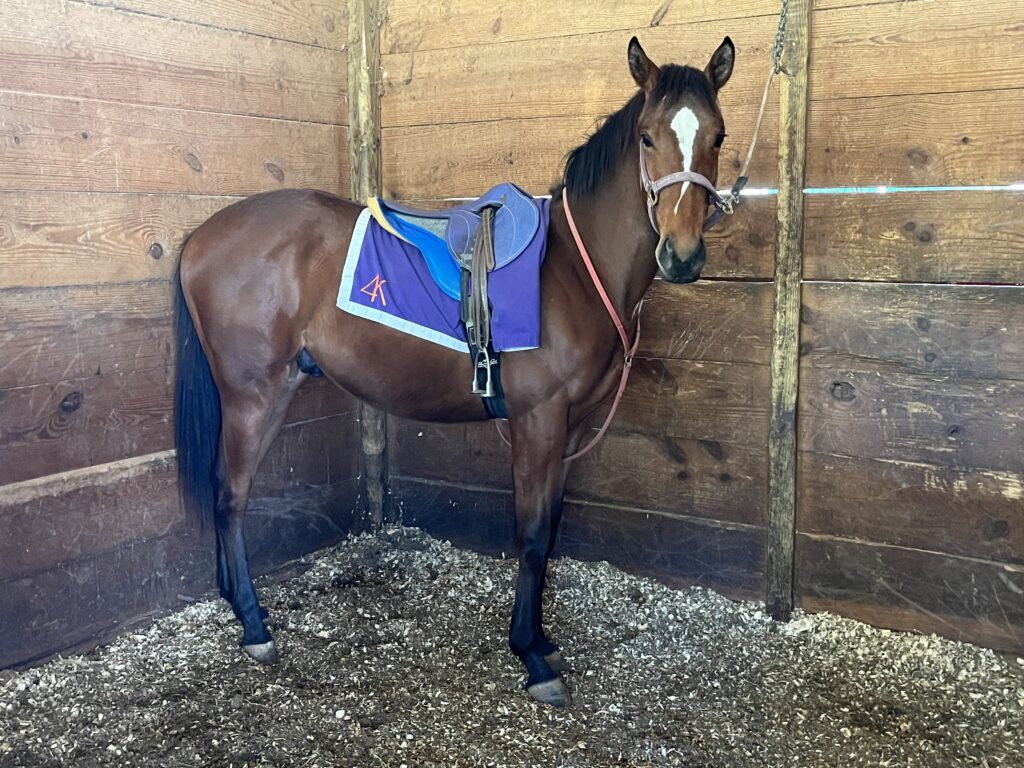Last updated: March 21, 2023
Any links on this page that lead to products on Amazon are affiliate links and I earn a commission if you make a purchase. Thanks in advance – I really appreciate it!
A saddle pad is not just a piece of cloth that sits under your saddle; in reality, they are necessary. However, there are so many types it’s often challenging to figure out which one you need and their purpose.
A saddle pad or blanket is what goes between the horse and saddle. It helps keep the underside of your saddle clean and absorb sweat while also providing cushioning. Saddle pads also prevent chafing and assist in keeping the saddle in place.
Saddle pads come in a wide range of sizes, shapes, and materials because they are designed for different riding styles and purposes. In this article, we’ll take an in-depth look at saddle pads so you can choose the best one for your needs.
Why saddle pads are necessary.
I like to keep a lot of saddle pads on hand to match the horse, saddle, and activity. I typically use the same pad for one horse, but for others, I often choose different pads depending on the saddle and rider.

In the olden days, nothing came between the horse’s back and its saddle. Things have changed now, and most riders agree that saddle pads are an essential horse riding tack.
Following are the main benefits and functions of a saddle pad:
1. To prevent the horse’s sweat from damaging the saddle
A good-quality saddle pad will prevent the sweat from the horse’s back and hair from damaging expensive leather saddles.
2. To eliminate friction and abrasion.
A saddle pad prevents friction caused by the saddle’s movement on your horse’s back, reducing the chances of chafing sores developing and minimizing generalized discomfort of riding for long periods.
3. Uniform pressure distribution
Saddle pads help distribute pressure from the rider and the saddle more uniformly across your horse’s back. Spreading the saddle’s weight helps protect your horse’s musculoskeletal system from uneven pressure that could result in back pain and injuries.
Some horses, especially those with sway backs, need a special correction pad to distribute the saddle’s weight.
4. Shock absorption
High-quality saddle pads also protect your horse from shocks when riding on uneven or rocky terrain.
5. Aids in saddle balance
Saddle pads also help the saddle conform and adhere better to your horse’s back. They prevent saddle imbalances and might even improve the saddle’s fit.
What are the differences between an English and a Western Saddle Pad?
Because a western saddle is large, heavy, and almost square-shaped, the saddle pad needs to be large. On the other hand, an English saddle is small, and the pads are as well.
English Saddles Pads ( Also called Numnah)
English saddle pads are generally thinner than western pads because English saddles are much lighter and have flocking to cushion the horses’ backs. Most English pads are designed to keep the saddle clean and would not fit under a western saddle.
English saddle pad sizes
In general, English saddle pads have a 17 – 19″ drop (the distance between the center seam to the bottom hem) and a 24 – 26″ spine (distance along pad’s length). However, if you ride in a large saddle, you may need to buy a larger saddle pad.
A typical full-size English saddle pad measures 22 inches wide to 46 inches long.

Western Saddle Pads
Compared to English pads, Western pads are heavier, thicker, and larger because Western saddles lack adequate cushioning. You can get them in different styles and sizes based on the saddle.
A western pad could fit under an English saddle, but you would want that since the saddle itself is heavily padded.
A typical full-size western saddle pad measures 32 inches by 32 inches. You also have pony or Children’s saddle pads measuring about 16 inches.
Could you ride a western saddle with an English saddle pad?
It would be best not to ride a Western saddle with a saddle pad designed for an English riding saddle. Western saddles are heavy and have little padding between the wood saddle frame (tree) and the horse’s back.
English saddle pads are not made to provide sufficient cushioning to protect a horse’s back from the weight of a Western saddle.
Can You Use a Saddle Blanket Instead of a Saddle Pad?
To answer this question, let us first consider what a saddle blanket is.
A saddle blanket is the original western riding saddle pad. Cowboys would use it during the day for riding and as a blanket at night for sleeping on.
Original saddle blankets are woven from wool and feature colorful Native American and Mexican designs. Since saddle blankets aren’t too thick, their use as saddle pads is limited only to pleasure and trail riding.
Remember: an everyday blanket on its own might not offer shock absorption as a saddle pad should, except for Navajo real wool blankets. Navajo saddle blankets are made of 100% natural wool, and they offer all of the benefits that saddle pads are meant to deliver.
Unfortunately, many saddle pad manufacturers are using synthetic pads and passing them off as Navajo wool blankets. These do not offer any of the shock absorption and uniform pressure distribution as high-quality saddle pads do.
Best materials used to make saddle pads.
Saddle pads range in budget, quality, and comfort. When selecting one, you must account for all these differences. Simple pads might be affordable but may not be therapeutic or comfortable.
Therapeutic saddle pads offer a wide range of benefits and utilize special materials. It is little wonder that these tend to be considerably more expensive.
The choice of pad material will depend on your needs. If you like long-distance trail rides or spend long hours working cattle, then the last thing you’d need is a pad that traps heat and moisture.
Instead, look for a material that wicks moisture and keeps the horse’s back cool and comfortable. If you ride only for short periods, or especially in the cold, you can go for pads that retain warmth.
Here are the most common materials used to make saddle pads:
Wool
Wool or wool felt is the traditional choice in saddle pad material. These days, they make pads of compressed wool, which range in thickness between ½ and 1 inch. Wool and wool-felt pads are graded. Without going into too much detail, the pads made of F10 and F11 felt are considered superior.
- ALL WOOL - All Natural Wool Saddle Pad - Made in USA
Prices pulled from the Amazon Product Advertising API on:
Product prices and availability are accurate as of the date/time indicated and are subject to change. Any price and availability information displayed on [relevant Amazon Site(s), as applicable] at the time of purchase will apply to the purchase of this product.
Here are the pros of wool felt saddle pads:
- Firm-yet-pliable
- Naturally flame-resistant
- Molds naturally to the horse’s back.
- Relatively high shock absorption.
- Disperses pressure evenly.
- Wicks moisture and sweat away from the horse’s back.
- Is breathable
Synthetic Pads
These are typically made from polyester or polypropylene, and some could comprise blends of wool and synthetic materials. Here are the pros of synthetic saddle pads:
Prices pulled from the Amazon Product Advertising API on:
Product prices and availability are accurate as of the date/time indicated and are subject to change. Any price and availability information displayed on [relevant Amazon Site(s), as applicable] at the time of purchase will apply to the purchase of this product.
- Cheaper than 100% woolen pads
- It helps prevent pressure points and offers good shock absorption.
- Warmer than woolen felt.
On the downside, synthetic pads are not as breathable as woolen pads.
Fleece Pads
You can get natural fleece as well as blends of woolen fiber with synthetic materials. Here are their benefits:
- Single weave acrylic woven top with a synthetic fleece liner
Prices pulled from the Amazon Product Advertising API on:
Product prices and availability are accurate as of the date/time indicated and are subject to change. Any price and availability information displayed on [relevant Amazon Site(s), as applicable] at the time of purchase will apply to the purchase of this product.
- Soft and cushioning.
- Moisture-wicking (when made of woolen fleece).
- Durable and long-lasting (when made of synthetic fleece).
- Warmer.
On the downside, they attract dirt easily and become harder to clean with age.
Neoprene saddle pads
The equine world started using neoprene pads in the 1900s. As a material, neoprene renders the following properties to the saddle pad:
- DESIGNED WITH YOUR HORSE’S COMFORT IN MIND - tack slippage can cause irritation, soreness, and even become dangerous for both horse and rider. With our comfortable, soft, breathable pure neoprene non-slip saddle pad, tack slippage will become a thing of t
Prices pulled from the Amazon Product Advertising API on:
Product prices and availability are accurate as of the date/time indicated and are subject to change. Any price and availability information displayed on [relevant Amazon Site(s), as applicable] at the time of purchase will apply to the purchase of this product.
- Very little maintenance needs.
- Clean and dries quickly.
- Flexible.
- Durable and long-life span.
- Waterproof; does not absorb sweat.
On the downside, it cannot disperse pressure like wool-felt pads.
Closed-cell and open-cell foam saddle pads
Both these types are made of polyurethane, and both types of foam are nothing but plastics with gas-filled cells or bubbles. Here are the benefits:
Prices pulled from the Amazon Product Advertising API on:
Product prices and availability are accurate as of the date/time indicated and are subject to change. Any price and availability information displayed on [relevant Amazon Site(s), as applicable] at the time of purchase will apply to the purchase of this product.
Closed-cell Foam Pads
- Firm, durable, and long-lasting.
- Good shock absorption and cushioning effect.
- It molds nicely to the horse’s back. It prevents the saddle from slipping.
- Easy to clean.
- Manufacturers claim you can use them on multiple horses without spreading skin issues.
On the downside, closed-cell foam pads absorb and retain heat, don’t wick moisture like wool pads, and are not breathable.
Open-cell Foam Pads
- Spongy and absorb liquids
- Light, flexible, dirt-resistant.
- More breathable than closed-cell foam pads
- Disperse pressure with uniformity
- Long-lasting.
- Retain shape after use.
On the downside, they don’t wick moisture as well as wool pads.
Gel-insert saddle pads
As the name indicates, these are gel-insert-filled plastic or vinyl pads. The gel helps the pad adhere well to the horse’s back.
- Comes with memory foam inserts; Adjustable
Prices pulled from the Amazon Product Advertising API on:
Product prices and availability are accurate as of the date/time indicated and are subject to change. Any price and availability information displayed on [relevant Amazon Site(s), as applicable] at the time of purchase will apply to the purchase of this product.
Here are its benefits:
- Improve shock absorption, comfort, and fit.
- Conform well to horse’s back.
- Offer superior cushioning effect.
On the downside, the gel inserts can add weight to the pads. Also, gel pads don’t perform as well as wool pads in terms of uniform pressure dispersion. They also compress with time and are not breathable.
The approximate cost of high-quality saddle pads.
- Wool saddle pads: Starting from $50 to $500
- Gel-insert pads: Between $50 and $400
- Sheepskin pads – start from $200
- Memory foam pads – Start from $60

Best Saddle Pads for Jumping, Dressage, and Western Pleasure Riding
- Jumping saddle pads are shorter than dressage pads. They also have a wing that is rounder than the pads used in dressage events. Look for a pad that won’t overheat your horse and also absorb sweat. Wool pads are ideal for jumping as they have excellent sweat absorption and uniform heat dispersion and keep a horse cool.
- Dressage pads are bigger than jumping saddle pads. Their wing part is longer too. Dressage pads are straighter in the front and more significant than jumping pads. The best dressage pads are quilted sheepskin, velvet, fleece and velvet blend, and other elegant materials.
- For everyday western pleasure riding, choose neoprene or wool felt pads. The former is easier to clean, while wool pads are moisture absorbing, flame-resistant, and mold well to the horse’s back.
Conclusion
Never ride a horse without a saddle pad, as it can cause pinching, abrasion, and back pain in horses. Every riding discipline has a saddle pad style that fits its saddle’s dimensions, weight, and purpose.
The last thing you’d want is direct contact between a hard saddle and your horse’s back. You can choose from various materials in saddle pads such as wool, neoprene, close/open-cell foam, gel-insert pads, and synthetic pads. Always consult an experienced equestrian before buying your pad.
Below is a helpful YouTube video showing how to fit a saddle pad.
FAQs
What is the most expensive saddle pad?
You won’t believe how much Hermes saddle pads cost! For a single dressage pad, you’re looking at $510 or more. But the most expensive is the Doudou Shock Absorbing Pad that retails for an eye-watering $730 each.
What are Impact gel saddle pads?
Impact gel pads are the latest innovation in gel-based pads. They have superior shock absorption and contain specialized gel. They are primarily used for boosting horse’s performance.
References
- HORSEMANS GT TACK & EQUIPMENT: By Cynthia McFarland
- https://www.ofhorse.com/view-post/A-Short-Sweet-Guide-to-Choosing-A-Saddle-Pad
- The Essentials of Horse-keeping By Rachel Hairston

About the Author: Miles Henry
Lifelong Horseman | Racehorse Owner | Published Author
Miles Henry brings over 25 years of hands-on experience training and owning Thoroughbred racehorses. Raised with Quarter Horses and Appaloosas, he’s spent a lifetime learning from horses—on the track, in the barn, and in the field. Today, he runs a small but successful racing stable in Louisiana and shares real-world insights on HorseRacingSense.com, helping horse owners, fans, and bettors navigate the sport with confidence.
📚 Books: View Miles’s books on Amazon »
🎧 Podcast Guest: Animal Tales Ep. 32 |
YouTube Interview
📩 Newsletter: Sign up for racing tips and horse care advice »
🔗 Follow Miles:
Twitter |
Facebook |
YouTube


